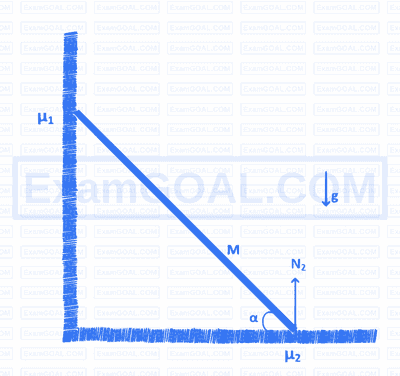Biology
Which of the following root modifications is observed in maize?
The following word diagram depicts a food chain in a forest.
$$ \text { Trees (Aspen, willow) } \rightarrow \text { Herbivore (Elk) } \rightarrow \text { Predator (Wolf) } $$
Which is the most likely outcome of depletion in predator population?
$$ \text { Match the human cell types or (column I) to the number of chromatids (column II) } $$
| Column I | Column II | ||
|---|---|---|---|
| (a) | Col$$G_2 \text { phase cells } $$ |
(i) | 46 |
| (b) | $$ G_1 \text { phase cells } $$ |
(ii) | 92 |
| (c) | Spermatogonia (pre-replication) |
(iii) | 23 |
| (d) | Ovum | ||
Chemistry
$$ \text { How many atoms are present in a hexagonal close-packed unit cell? } $$
$$ \text { What is the most appropriate Lewis structure of } \mathrm{NO}_2 \mathrm{~F} \text { ? } $$


$$ \text { The number of unpaired electron(s) in the square planar complex }[\text{Ni}(\text{CN})_4]^{2-} \text { is/are } $$ :
$$ \text { Select the most appropriate compound I and the reagents for the synthesis of compound II } $$

$$ \text { Identify the final major product III in the following reaction sequence: } $$

Mathematics
If $p(t)=\frac{t(t-1) \cdots(t-2019)}{2019!}$, then the value of
$$ \int_0^1\left(\frac{1}{t+1}+\frac{1}{t+2}+\cdots+\frac{1}{t+2020}\right) p(-t-1) d t $$
is:
$$ \text { Define binary operation * on } Q \text { by } a * b=a+b-3 \text {. The inverse of } 2 \text { with respect to * is } $$
Let $[x]$ denote the greatest integer less than or equal to $x$. The number of positive integer solutions of the equation
$$ \left[\frac{x}{19}\right]=\left[\frac{x}{20}\right] $$
are:
Let $f: \mathbb{R} \rightarrow \mathbb{R}$ and $g: \mathbb{R} \rightarrow \mathbb{R}$ be two functions such that
$$ g \circ f(x)= \begin{cases}x^2, & \text { if } x \geq 0 \\ e^x-1, & \text { if } x<0\end{cases} $$
Then which of the following statements is correct?
$F(x)=\int_0^{e^x}\left(t^3+2 t^2-t-2\right) d t$, then for how many real numbers $x$ does $F^{\prime}(x)=0$ ?
Let $C$ be a circle which passes through $(-2,1)$ and $(0,3)$ and whose centre lies on the line $y-x=1$. Then which of the following points lies on $C$ ?
A bag contains 8 balls, of which 5 are green and 3 are red. The probability that two balls chosen at random are of the same colour is :
Physics
The potential energy of a point particle of mass $m$ undergoing rectilinear motion along the $x$-axis is given by
$$ V(x)=A x+B x^2 $$
What is the maximum speed attained by the particle if it starts from rest at $x=\frac{A}{B}$ ?
Two identical containers kept at the same temperature carry the same gas with different molecular mean free paths $l_1$ and $l_2$. The gas from the first container is completely transferred into the second at the same temperature. What is the molecular mean free path of the resultant mixture in the second container?
Consider the circuit with a Zener diode whose breakdown voltage $V_z=4 \mathrm{~V}$. What is the voltage $V_0$ if $V_i=20 \mathrm{~V}$ ?

Consider a mass-pulley system as shown in the figure. There is a wedge of mass $M$ and equal wedge angles $\theta$ lying on a rigid horizontal table. The coefficient of friction between the wedge and the table is $\mu$. There are two blocks of mass $m_1$ and $m_2$ lying on the incline of the wedge. The coefficients of friction between the blocks and wedge are $\mu_1$ and $\mu_2$ as shown in the figure. Consider $m_1>m_2$ and the coefficients of friction ( $\mu, \mu_1$ and $\mu_2$ ) to be less than $\tan \theta$. Gravity is acting downwards with acceleration due to gravity $g$. What should be the value of $\frac{m_1}{m_2}$ so that the system is in equilibrium?

What is the maximum angle of incidence $\theta_i$ in the figure for which the ray would satisfy the condition for total internal reflection at the boundary of media of refractive indices $n_1$ and $n_2$, where $n_1>n_2$ ?
+
$$ \text { What is the equivalent resistance between the points } A \text { and } B \text { in the figure? } $$


The acceleration due to earth's gravity on a point particle at a height $h$ above the surface of the earth is denoted by $g_o(h)$ and at a depth $d$ below the surface of the earth is denoted by $g_i(d)$. Consider the earth to be a sphere of radius $R$ with uniform mass density. Which of the following correctly represents the ratio $g_i(d) / g_o(d)$ ?
Consider an infinite one-dimensional wire carrying a uniform current $I$ as shown in the figure. A square loop of side $a$ is initially placed such that the center of the loop is at a distance $R$ from the wire, where $R>\frac{a}{2}$. The square loop is then moved rightwards with a uniform speed as shown in the figure. What is the induced emf in the loop as a function of time $t$ ?

The electric field of an electromagnetic wave is given by $\vec{E}(x, t)=E_0 \hat{z} \cos (a x+b t)$
If $c$ is the speed of light, then the value of $b$ is
An electron of mass $m_e$ has a speed $u_n$ in the $n^{\text {th }}$ Bohr orbit of a hydrogen atom. The normalized speed $V_n$ is given as $V_n=u_n / c=1 / 685$ and the mass of the electron in the units of energy is given as $M_e=m_e c^2=0.51 \times 10^6 \mathrm{eV}$, where $c$ is the velocity of light in a vacuum. It is given that $\frac{e^2}{2 \epsilon_0 h c}=1 / 137$. The Planck's constant h is given as $4.13 \times 10^{-15} \mathrm{eV}-\mathrm{sec}$. The electron makes a transition from $n^{\text {th }}$ orbit to the ground state of the atom. What is the frequency of the emitted photon?